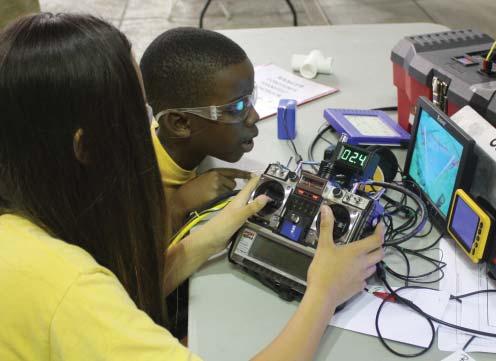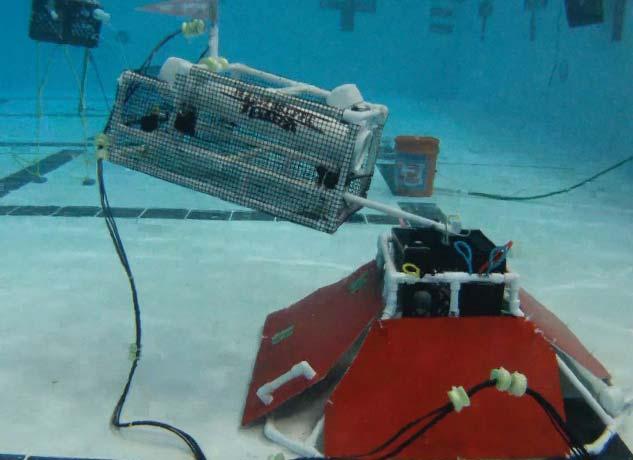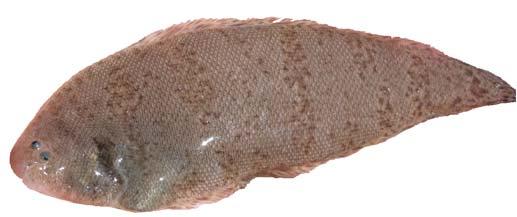
9 minute read
9 Ebb & Flow - Speckled Trout
Speckled Trout
By Trey Leggett
Advertisement
Iremember back in the day when I’d go fi shing with the intent of catching and keeping the maximum limit of fi sh of a particular species. My target on many occasions was speckled trout. Not only are they fun to catch, but they’re very tasty battered up and bathed in some hot grease! I’d keep and freeze enough fi sh to have a couple of sizable fi sh frys during the year for family and friends. But it seems as though times are changing and it’s getting harder to fi nd the numbers we once had. Size and creel limits are getting tougher and fi nding the fi sh is getting tougher.
Let’s talk about speckled trout (AKA spotted seatrout or spotted trout). These fi sh mature at the age of two and can start spawning at 12 to 13 inches in length. Of course, the bigger the trout, the more eggs they’ll produce during the spawn. During the Georgia spawn (April – June), each mature trout can lay hundreds of thousands of eggs. Many of these eggs are eaten by predators, some travel to other areas of the coast, or they may stay, reach maturity and produce fry. Anyway, a small egg getting to a mature size is truly a remarkable struggle due to environmental conditions, predators and other factors. What you fi nd back in our estuaries are what survived.
Over the last few years, fi shery management personnel have discussed, argued, and studied various sorts of data until they were blue in the face. I know, I was one of them. The tough decision to change the speckled trout size limit was made and was implemented in 2017. Although not a favored decision by all anglers, it was made for a stronger stock and improvement of numbers for the future. Not sure about you, but I want to have plenty of fi sh frys when I retire! You can go to the GADNR Coastal Resources Division website and read much more about stock assessments and such than I can explain here: coastalgadnr.org/sites/default/ fi les/crd/RecFish/State_FMPs/SpottedSeatroutFMP2017.pdf
During the spawning season, speckled trout can be found at or near oceanside inlets. Spawning trout release their eggs in the inlets or beachside, supposedly to enhance egg survival from small estuary predators. Yet these trout are then susceptible to being targeted by their own predators by being in more open waters, which means they must swim more vigorously. Their enhanced movements coupled with swimming in more direct currents cause these trout to tire and they must eat. They feed very aggressively and with a clear purpose, to refuel and gain strength before their next spawn. I’ve caught female trout during the spawn that nearly
A beautiful speckled trout! Photo by Trey Leggett
ripped the rod from my hands. They’re very powerful and focused on their objective, which makes it sort of like shark fi shing. The majority of trout that I catch during the spawn are generally in the 18- to 24-inch range.
I use the same rod and reel setups when targeting spawning trout as I do with regular trout fi shing: medium-weight with 10- to 20-pound main line, tied to a 25-pound fl uorocarbon leader. I have the most success on live shrimp or mud minnows hooked on a quarter ounce jig head. I’ll throw the presentation up current and let it drift across the bottom, or I may reel it back slowly. You can also have success with artifi cial lures if you can get to the right level of the water column where these fi sh are swimming.
Remember, I love catching and keeping fi sh to eat, but I also love releasing any trout over 18 inches in length, so more babies can be laid for future fi shing trips and for future fi shermen. Have fun during this speckled trout spawning season!
Stay safe and tight lines!
Trey fi shes for Hobie Polarized Sunglasses, and ENGEL Coolers. Email: info@southerntidesmagazine.com
By LTJG Marybeth Head
NOAA Corps Off icer & Vessel Operations Coordinator Gray’s Reef National Marine Sanctuary
Kids these days always appear to have their heads down in phones and hidden behind computers, living in a digital world. We might assume they are being unproductive and not planning to contribute to the workforce. However, the world of science and engineering has taken notice of kids’ immersion in technology. Today, the marine exploration and ocean observation industries are booming, and young adults comprise the majority of the workforce driving innovation. Marine technology is a career path that inspires people of all backgrounds, beliefs and identities to come together, problem solve and invent.
At Gray’s Reef National Marine Sanctuary, we utilize technologies that weren’t available 20 years ago. For example, we gather data from an ocean glider, an autonomous unmanned water vehicle that collects information on temperature, salinity and carbon dioxide. The only permanent man-made object in the sanctuary is the iconic yellow data buoy that updates wind speed, wave height and temperature in real time. Recreational boaters and anglers all over our coast use that information. Occasionally, large NOAA research vessels use technology to map the sea fl oor and to track tagged animals at Gray’s Reef. Among youth, the ground swell of enthusiasm for technology can be witnessed right here at the Gray’s Reef Southeast Regional Marine Advanced Technology Education (MATE) ROV Competition.
Gray’s Reef hosts the ROV competition every year in April at the Chatham County Aquatic Center. It is where students from middle school to university level can work in teams to build underwater robots – ROVs -- to solve today’s engineering problems. This year’s theme is Jet City: Aircraft, Earthquakes and Energy. The mission encourages kids to think about real issues: underwater archaeology, seismology and renewable energy. Each team pilots their ROV through pre-set underwater scenarios in front of professional engineers and professors. The students also must “market” their ROVs as commercial products to a panel of judges.
A remarkable fact about this the competition is that it is an extracurricular activity and the students build their incredible robots after they have completed all their schoolwork. It is no easy task, but their high-energy engagement is a force to be reckoned with. On the big day, the aquatic center is packed to the gills with smiling faces, and cheering is loud enough to think you were at a sporting event! The pool deck is covered in teams in snappy uniforms eagerly holding their ROVs, waiting for their turn to compete. Marine technology is everywhere, and the students love it.
If given the opportunity, today’s youth will surprise us. Come and support these extraordinary young people on April 21; the fi rst ROV will be in the water around 10:00 a.m. These kids may grow up to be the next generation of marine scientists and engineers working off our shoreline!
For more information, email michelle.riley@noaa.gov

Students from the Carrollton Middle School Oceaneers operate their ROV during the competition at the Chatham County Aquatic Center. Photo by Jody Patterson/GRNMS

ROV in operation during the Gray's Reef Southeast Regional MATE ROV Competition. Photo provided by GRNMS

GoPro shot of an ROV working around obstacles during the competition. Photo provided by GRNMS
Did You Know? Taste of the Tides
Although hogchokers, black-cheeked tonguefish, and flounder share similar flat body types that allow them to easily be mistaken for one another, they are three distinct fish that differ in size, shape, and color.
Baked Blue Crab Dip
By Amy Thurman

Hogchokers (Trinectes maculatus) are Hogchokers (Trinectes m small, less than six inches at small, less than maturity, and can be maturity, found in estuaries found and coastal rivers. and c These fi sh are fl at The and round with and frilled fi ns to fril help hide it from hel prey. Both eyes prey are affi xed to the are a top of their heads, top of and they are usually and they dark brown in color with dark brown i thin spots and banding along their bodies. The name came about when farmers fed these fi sh to hogs, but the fi sh’s bony body made it hard to eat.
Juvenile hogchoker. Photo by Amy Thurman

Black-cheeked tonguefi sh (Symphurus plagiusa) typically grow to be less than 13 inches in length. Tonguefi sh are common in shallow coastal areas where it hides in soft, muddy sediments. They feed on small eed on small animals like worms s like worms and copepods. pepods. On their “eye eir “eye side,” they hey are tan to to brown with dark, narrow w bands that that refl ect the sediment they are living in. They also have a large black patch near their gills, hence the name.

Juvenile black-cheeked tonguefi sh. Photo by Amy Thurman
g Flounder are also bottom-dwelling fi sh that live on muddy or sandy muddy or sandy bottoms. In Georgia, the most ia, the most common species is summer is summer fl ounder (Paralichthys dentatus). s dentatus). They average about 10 bout 10 inches in length, olive to live to brown in color, and can d can be distinguished by large large dark spots along the body. body. They’re considered “left“lefthanded” fi sh because the e the eyes and mouth are on the n the left (top) side of the body. body. This is the only one of the e of the three species that is recreationally fi shed. i llfihd


Juvenile four-spot fl ounder. Photo by Erin Weeks, SCDNR
It takes a lot of energy to pick enough blue crab for this dish, so bribe someone to help you! Blue crabs can be found at your local seafood market right now!
INGREDIENTS
8 - 12 ounces blue crab meat 1 8-ounce package cream cheese, softened 1 cup mayonnaise (try olive oil mayo for a healthier option) 1/2 cup cheddar cheese, grated 1/2 cup jack cheese, grated (pepper jack optional) 1/4 cup celery, finely diced 1/4 cup Vidalia onion, finely diced 1 clove garlic, minced 1 tablespoon olive oil 2 teaspoons Cajun seasoning (or Old Bay if you prefer) 1 tablespoon lemon juice Paprika
DIRECTIONS
•Preheat oven to 350 •In small sautè skillet, sautè celery, onion and garlic just enough to lightly soften. Place on paper towel and blot to remove excess oil. •Mix cream cheese, grated cheese and mayo together in a mixing bowl until well-blended. Cream cheese that has come just to room temp will be easier to mix. (Cheese that has been grated by hand from a block has a better melting consistency.) •Stir in vegetables, Cajun seasoning and lemon juice. •Stir in crab meat. •Scoop dip mixture into a lightly greased casserole dish. •Bake at 350 for 20 minutes or until top is light golden brown. •Dust with paprika. Serve with crostini, crackers, sturdy chips, or celery Note: You can play around with this and use diff erent cheeses, add more or less celery or onion, and additional seasonings to taste!








